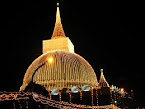This would be one of the most difficult questions to answer in any context, be it religious, philosophical or scientific. Many scientific researches and investigations are carried out to seek a proper answer for this question. In Buddhism, Abhidhamma is the area which would explore the mind and its various features and classes.
There could be many ways in which the existence of mind would be expressed. Primarily, the mind is the entity to think. Chittha Wagga in “Dhamma Padaya” examines various features and behaviors of mind. Mind is the most powerful element in oneself. For example, a person who is weak in controlling mind would get excited and panic easily in difficult situations. That person may start suffering from high blood pressure or would be sweating or shivering in such circumstances. A person with a controlled mind would handle such situations better. Hence, if mind has such a command in our body it would not be difficult to comprehend that controlled, improved and purified mind would be the key to achieve the serene joy in ones life by attaining Nibbana.
A particular visible object which is seen as attractive to one person would be viewed as disgusting by another person. The process, which would identify that object seen by eyes and decide it to be attractive or disgusting, is associated with mind. Similarly, sound, odour, taste and touches are acquired by ears, nose, tongue and body which is called Five Sense Organs (Pancha Indriya) and it is the mind which is associated in deciding about them. In addition to these five sense organs mind itself (which is also called as mano) is considered as the sixth organ to attract senses called dhamma.
When mind is connected with the brain it is called Mano. When mind is connected with heart it is called Chittha. When it is referred in five aggregates (Panchakkhandha) it is called Vinnana. In Abhidhamma all these terms are synonymous. In the first two realities (Chittha Paramaththa & Chetasika Paramaththa) the forms of mind, its features, behaviors, associations and engagements would be comprehensively analyzed. In this presentation the term “Chiththa” and the corresponding English term “Consciousness” would be used to refer to the mind.
The Reality of Consciousness (Chiththa Paramaththa)
Every fraction of ones Samsara is associated with consciousness. It is a thought process which continues till the end of Samsara. In this thought process there arise various types of consciousnesses. There are many classifications for these consciousnesses based on various factors.
Places of consciousness
Depending on the place they arise consciousness is fourfold;
- Consciousness pertaining to the Sensuous-Sphere (Kamavachara Chiththa)
- Consciousness pertaining to the Form-Sphere (Rupavachara Chiththa)
- Consciousness pertaining to the Formless-Sphere (Arupavachara Chiththa)
- Supramundane consciousness (Lochuththara Chiththa)
Where we live is in the “Human Realm” (Manussa Loka) which is one of the eleven types of sentient existence worlds (Kama Loka). The others are four states of misery (Apaya), six celestial realms (Divya Loka). Kama in other words means the sensual craving on forms (sight), sounds, odour, taste and touches which is experienced in all these eleven worlds. Therefore, consciousness which frequents (avachara) in these worlds are known as Kamavachara Chiththa. There are 54 of them in number.
He who meditates extensively is capable of achieving much higher mental state of ecstasy which is called Jhana. There are two types of Jhana: Rupa and Arupa. He who developed these kinds of Jhanas is born in corresponding Form-Sphere (Rupa Loka) or Formless-Sphere (Arupa Loka). Consciousness developed in these states of mind or consciousness pertains in these spheres are called as Rupavachara Chiththa and Arupavachara Chiththa. They are 15 and 12 respectively in numbers.
The above three types of consciousness is called mundane (Lokiya). The fourth type of consciousness is the most supreme of all. This type of consciousness pertains to the one who enters the stream that leads to Nibbana. That is in stages of sainthood starting from Sothapaththi then Sakhadhagamin, Anagami and Arhath. They are either 8 or 40 based on two different classification which makes the total number of consciousness is either 89 or 121 which is to be elaborated in future.
Nature of consciousness
A volitional act which is capable of causing Kamma is caused either by Immoral Causes/Roots (Akusala Hethu) or Moral Causes/Roots (Kusala Hethu). Immoral causes are attachment (Lobha), aversion or ill will (Dwesha) and ignorance (Moha). Moral causes are non-attachment or generosity (Alobha), goodwill (Adwesha) and wisdom (Amoha). The types of consciousness caused by immoral roots are called Immoral Consciousness (Akusala Chiththa) and that caused by moral roots are called Moral Consciousness (Kusala Chiththa).
There is another type of consciousness which arise as a result Kamma of Kusala & Akusala Chiththas. Those are called Resultant Consciousness (Vipaka Chiththa). All the karmic action performed by Arhaths does not have any Kammic effect. But they too engage in various good deeds. The type of consciousness arise for them is known as Functional Consciousness (Kiriya Chiththa).
The above mentioned immoral and moral consciousness arises with roots. Therefore they are together called Sahethuka. There is a certain class of consciousness which arise without any roots as well and they are called Ahethuka.









0 comments:
Post a Comment